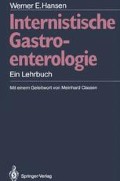Zusammenfassung
Der Dünndarm ist der Teil des Gastrointestinaltrakts, in welchem die Nahrungsstoffe endgültig zerlegt und in einzigartiger Weise in den Körper aufgenommen werden:während nützliche Bestandteile rasch absorbiert werden, werden schädliche oder wertlose Inhalte inaktiviert bzw. zurückgehalten und in das Kolon bzw. den Stuhl weitergeschoben. Trotz des intensiven Kontakts mit einer Vielzahl von potentiell gefährlichen Substanzen bzw. Erregern werden Dünndarmerkrankungen — abgesehen vom Zwölffingerdarmgeschwür — (s. 3.6) im Vergleich nur selten beobachtet. Leitsymptome sind Durchfälle und Gewichtsabnahme. Wegsamkeitsstörungen (Subileus, Ileus) zeigen sich durch Schmerzen, Übelkeit oder Erbrechen. Infektionen bzw. Infestationen betreffen in der Regel den gesamten Darmtrakt einschließlich dem Kolon:sie werden deshalb im nächsten Kapitel behandelt. Aus diesem Grund erfolgt dort auch die Besprechung des M. Crohn sowie der Zirkulationsstörungen.
Access this chapter
Tax calculation will be finalised at checkout
Purchases are for personal use only
Preview
Unable to display preview. Download preview PDF.
Literatur
Amman R (1957) Zur Differentialdiagnose, Pathogenese und Ätiologie des Morbus Whipple. Helv Med Acta 241:118
Caspary WF (1982) Das Malabsorptionssyndrom. Dtsch Ärztebl 79:37–47
Dicke WK, Weijers HA, van de Kamer JH (1983) Coeliac disease, presence in wheat of a factor having deleterious effect in cases of coeliac disease. Acta Paediatrica 42:34–42
Lessof MH, Wraith DG, Merrett TG (1980) Food allergy and intolerance in 100 patients — local and systemic effects. Q J Medicine 195:259–271
Morris JA, Selivanov V, Sheldon GF (1983) Nutritional management of patients with malabsorption syndrome. Clin Gastroenterol 12:463–474
Newcomer AD, Hofmann AF, DiMagno EP (1978) Triolein breath test:a sensitive and specific test for fat malabsorption. Gastroenterology 76:6–13
Tabaqchali S, Booth CC (1967) Relationship of the intestinal bacterial flora to absorption. Br Med Bull 23:285–290
Trier JS (1971) Diagnostic value of peroral biopsy of the small intestine. N Engl J Med 285:1470–1473
Van de Kamer JH, Heunik HTB, Weyers HA (1949) Rapid method for the determination of fat in feces. J Biol Chem 177:347–355
Author information
Authors and Affiliations
Rights and permissions
Copyright information
© 1987 Springer-Verlag Berlin Heidelberg
About this chapter
Cite this chapter
Hansen, W.E. (1987). Dünndarm. In: Internistische Gastroenterologie. Springer, Berlin, Heidelberg. https://doi.org/10.1007/978-3-642-71869-4_4
Download citation
DOI: https://doi.org/10.1007/978-3-642-71869-4_4
Publisher Name: Springer, Berlin, Heidelberg
Print ISBN: 978-3-642-71870-0
Online ISBN: 978-3-642-71869-4
eBook Packages: Springer Book Archive

